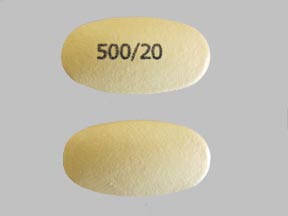Esomeprazole/naproxen and Alcohol/Food Interactions
There are 5 alcohol/food/lifestyle interactions with esomeprazole / naproxen.
Naproxen Alcohol (Ethanol)
Moderate Drug Interaction
GENERALLY AVOID: The concurrent use of aspirin or nonsteroidal anti-inflammatory drugs (NSAIDs) and ethanol may lead to gastrointestinal (GI) blood loss. The mechanism may be due to a combined local effect as well as inhibition of prostaglandins leading to decreased integrity of the GI lining.
MANAGEMENT: Patients should be counseled on this potential interaction and advised to refrain from alcohol consumption while taking aspirin or NSAIDs.
References (1)
- (2002) "Product Information. Motrin (ibuprofen)." Pharmacia and Upjohn
Naproxen Alcohol (Ethanol)
Moderate Drug Interaction
GENERALLY AVOID: Theoretically, proton pump inhibitors may decrease the gastrointestinal absorption of enteric-coated naproxen, which requires an acidic environment for dissolution. The proposed mechanism is an increase in gastric pH (i.e. decreased gastric acidity) induced by proton pump inhibitors. In patients treated with proton pump inhibitors, the possibility of a reduced or subtherapeutic response to enteric-coated naproxen should be considered.
MANAGEMENT: Concomitant use of these drugs is generally not recommended.
References (1)
- (2002) "Product Information. Naprosyn (naproxen)." Syntex Laboratories Inc
Esomeprazole Food
Moderate Food Interaction
ADJUST DOSING INTERVAL: Food may interfere with the absorption of esomeprazole. The manufacturer reports that the area under the concentration-time curve for esomeprazole following a single 40 mg dose was 33% to 53% lower when administered after food intake as opposed to during fasting conditions.
MANAGEMENT: Esomeprazole should be taken at least one hour before meals. When administered to patients receiving continuous enteral nutrition, some experts recommend that the tube feeding should be interrupted for at least 1 hour before and 1 hour after the dose of esomeprazole is given.
References (2)
- (2001) "Product Information. Nexium (esomeprazole)." Astra-Zeneca Pharmaceuticals
- Wohlt PD, Zheng L, Gunderson S, Balzar SA, Johnson BD, Fish JT (2009) "Recommendations for the use of medications with continuous enteral nutrition." Am J Health Syst Pharm, 66, p. 1438-67
Switch to consumer interaction data
Naproxen High Blood Pressure (Hypertension)
Major Potential Hazard, Moderate plausibility
NSAIDs - fluid retention
Fluid retention and edema have been reported in association with the use of nonsteroidal anti-inflammatory drugs (NSAIDs), including some topical formulations. NSAIDs (including topicals) can lead to new onset of hypertension or worsening of preexisting hypertension, either of which can contribute to the increased incidence of cardiovascular events. NSAIDs should be used with caution in patients with preexisting fluid retention, hypertension, or history of heart failure. NSAIDs should be avoided in patients with severe heart failure unless the benefits are expected to outweigh the risk of worsening heart failure; if an NSAID is used in such patients, they should be monitored for signs of worsening heart failure. Blood pressure and cardiovascular status should be monitored closely during the initiation of NSAID treatment and throughout the course of therapy.
References (19)
- (2002) "Product Information. Motrin (ibuprofen)." Pharmacia and Upjohn
- (2002) "Product Information. Nalfon (fenoprofen)." Xspire Pharma
- (2002) "Product Information. Indocin (indomethacin)." Merck & Co., Inc
- (2002) "Product Information. Orudis (ketoprofen)." Wyeth-Ayerst Laboratories
- (2002) "Product Information. Naprosyn (naproxen)." Syntex Laboratories Inc
- (2006) "Product Information. Anaprox (naproxen)." Roche Laboratories
- (2001) "Product Information. Clinoril (sulindac)." Merck & Co., Inc
- (2001) "Product Information. Tolectin (tolmetin)." McNeil Pharmaceutical
- (2001) "Product Information. Voltaren (diclofenac)." Novartis Pharmaceuticals
- (2001) "Product Information. Relafen (nabumetone)." SmithKline Beecham
- (2001) "Product Information. Dolobid (diflunisal)." Merck & Co., Inc
- (2001) "Product Information. Ansaid (flurbiprofen)." Pharmacia and Upjohn
- (2001) "Product Information. Lodine (etodolac)." Wyeth-Ayerst Laboratories
- (2001) "Product Information. Daypro (oxaprozin)." Searle
- (2001) "Product Information. Celebrex (celecoxib)." Searle
- (2001) "Product Information. Mobic (meloxicam)." Boehringer-Ingelheim
- (2012) "Product Information. Meclofenamate Sodium (meclofenamate)." Mylan Pharmaceuticals Inc
- (2016) "Product Information. Flector Patch (diclofenac topical)." Actavis U.S. (Alpharma USPD)
- (2022) "Product Information. Feldene (piroxicam)." Pfizer U.S. Pharmaceuticals Group, SUPPL-52
Naproxen High Blood Pressure (Hypertension)
Moderate Potential Hazard, Moderate plausibility
naproxen - sodium
Anaprox and Anaprox DS (brands of naproxen sodium) contain 25 mg and 50 mg of sodium per tablet (approximately 1 mEq/250 mg naproxen), respectively, and Naprosyn suspension contains 39 mg per teaspoonful (approximately 1.5 mEq/125 mg naproxen). The sodium content should be considered when these products are used in patients with conditions that may require sodium restriction, such as congestive heart failure, hypertension, and fluid retention.
References (2)
- (2002) "Product Information. Naprosyn (naproxen)." Syntex Laboratories Inc
- (2006) "Product Information. Anaprox (naproxen)." Roche Laboratories
Switch to consumer interaction data
Esomeprazole/naproxen drug interactions
There are 581 drug interactions with esomeprazole / naproxen.
Esomeprazole/naproxen disease interactions
There are 15 disease interactions with esomeprazole / naproxen which include:
- asthma
- fluid retention
- GI toxicity
- rash
- renal toxicities
- thrombosis
- C. diff
- liver disease
- sodium
- anemia
- hepatotoxicity
- hyperkalemia
- platelet aggregation inhibition
- bone fractures
- hypomagnesemia
More about esomeprazole / naproxen
- esomeprazole/naproxen consumer information
- Check interactions
- Compare alternatives
- Pricing & coupons
- Reviews (60)
- Drug images
- Side effects
- Dosage information
- During pregnancy
- Drug class: Nonsteroidal anti-inflammatory drugs
- En español
Related treatment guides
Drug Interaction Classification
| Highly clinically significant. Avoid combinations; the risk of the interaction outweighs the benefit. | |
| Moderately clinically significant. Usually avoid combinations; use it only under special circumstances. | |
| Minimally clinically significant. Minimize risk; assess risk and consider an alternative drug, take steps to circumvent the interaction risk and/or institute a monitoring plan. | |
| No interaction information available. |
Further information
Always consult your healthcare provider to ensure the information displayed on this page applies to your personal circumstances.


